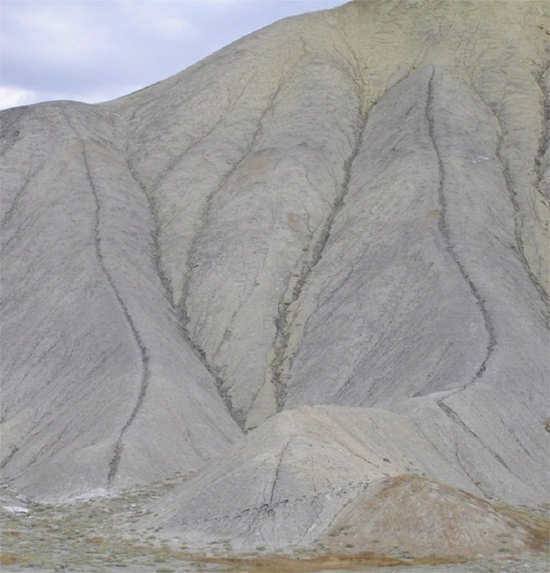
Eroded flanks of cliffs near Palisades, CO. Photo by author.
Jan 14, 2012
Balanced rock formations are common. But how to explain balanced water?
At first thought, one would not expect water to run down the hip ridge of a hill. The gravitational condition is unstable equilibrium: any deviation from the exact locus of highest points will perpetuate the deviation, and the water will run down the side of the hill. The sinuousness of the channel emphasizes its defiance of the gravitational condition: some force must pull the deviant water back toward equilibrium. The channel seems to oscillate along the ridge as one would expect in a condition of stable equilibrium.
At second thought, it may occur to one that the Earth sports an electric field in addition to its gravitational field. This has been noted but little investigated. Almost never does one take it into account when devising such explanations as water erosion.
Water is a polar molecule and has some responsiveness to electric fields. But how much is this a factor in rain draining down a ridge? Electric fields tend to concentrate at sharp edges and high points. Conceivably, the electric field along a ridge could have the morphology of stable equilibrium: strongest at the ridge and weakening to each side. The momentum of a water molecule would be constrained by an inverse electrical force to oscillate about the ridge axis as it moves down the “trough” of the ridge-maximized electric field.
The electrical force must be only slightly greater than the gravitational force, or it may be so only intermittently or discontinuously, because many of these ridge rilles eventually do run off to the side.
To underscore the resemblance of these ridge rilles to the more familiar lunar and Martian rilles, one may note that several seem to be composed of crater chains. Readers of these pages will be aware of the contention that electrical discharges excavated those extraterrestrial rilles. Were these rilles formed during lightning strikes to higher ground? Did a final “leakage spark” excavate them into the top when the ridges were electrically deposited? Is there a lower-energy process by which dark mode discharges can etch such formations? Rainwater would then opportunistically follow the electrical channel and enlarge it with a contribution of mechanical erosion.
Perhaps because humans have no sensory apparatus that is sensitive to specific electrical properties, such as sharks, birds, and platypuses are said to have, we ignore electricity in nature. When it forces itself onto our attention, we find it spooky and a bit frightening. In this modern day, when we have many instruments that can fill in for our biological lack, and when we have been made aware of the ubiquity of electrical phenomena, we must reexamine all the mechanical theories that we have inherited and taken for granted to get some idea of whether they should be revised to take electricity into account.
Mel Acheson












